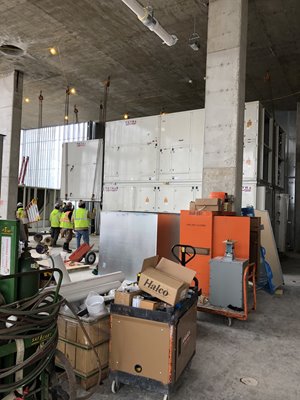 Soaring nearly 400 feet above Euclid Avenue in downtown Cleveland, The Lumen is the tallest residential building in Ohio.
Soaring nearly 400 feet above Euclid Avenue in downtown Cleveland, The Lumen is the tallest residential building in Ohio.
The 318-apartment building represents the transition of Playhouse Square from an entertainment-focused theater district into an urban mixed-use neighborhood.
The residential project — the largest in Cleveland in 40-plus years — also introduces a new building typology, materiality and architectural style to the neighborhood.
Geauga Mechanical, based in Chardon, Ohio, specializes in the multi-family residential market, with experience in market-rate apartments, affordable housing, luxury apartments and energy efficient (green) apartments. They were hired as the mechanical contractor to do the HVAC and duct work, and this is their tallest and largest project to date, explains CEO Craig Berman.
Downtown Cleveland’s Tallest Residence
The 34-story Lumen tower is composed of three stacked masses. Each mass shifts slightly outward. By day, the all-glass tower reflects the surrounding historic masonry buildings. At night, the lights from within the residences carry the street level activity of Euclid Avenue upwards, creating a beacon for the district that is visible from downtown.
Inspired by the theaters surrounding the site, the garage façade is an undulating metal screen that mimics a stage curtain. In the evening, it is illuminated with projections of current and upcoming shows and performances.
Geauga Mechanical started the project in 2018 on the bottom floors and worked its way up the 34-story building, Berman said.
The building includes the apartments, ranging from studios to three-bedroom units, and 20,000 square feet of amenity space, including an outdoor pool, BBQ/firepit area, and a sky lounge and terrace with panoramic views of the city and Lake Erie.
When you have a building without glass walls, you have an opportunity to bring in air or exhaust air outside of the building at different points. But with a full glass building like the Lumen, you must take things vertically. In this building, that means going straight to the roof. But to move air that distance vertically meant putting shafts and ductwork in that gets progressively bigger as it goes up. With apartments starting on the fourth floor, this adds even more air to the duct moving vertically from this point as well.
The project required 19,500 sheet metal hours on the job and 150,000 pounds of ductwork.
In the Lumen, Geauga Mechanical used an energy recovery unit for bringing in fresh air and exhausting kitchen and bathroom air. The unit, manufactured by Petra, can move 54,000 CFM of outdoor fresh air and 46,500 CFM of exhaust air, serving all of the apartments and common areas.
.png?width=300&height=400) In winter, the energy recovery wheel preconditions the incoming fresh air from 0 degrees to 35 degrees. This is done by using the heat in the air being exhausted from the building and transferring it to the cold fresh air coming into the building. In the summer, the energy recovery wheel reduces the incoming fresh air temperature from 90 degrees to 81 degrees, and also reduces humidity. This is done by exchanging energy from the cool/dry air leaving the building and the hot/humid air being brought into the building.
In winter, the energy recovery wheel preconditions the incoming fresh air from 0 degrees to 35 degrees. This is done by using the heat in the air being exhausted from the building and transferring it to the cold fresh air coming into the building. In the summer, the energy recovery wheel reduces the incoming fresh air temperature from 90 degrees to 81 degrees, and also reduces humidity. This is done by exchanging energy from the cool/dry air leaving the building and the hot/humid air being brought into the building.
Adapting Operations Mid-Project More Than 30 Stories Up
In 2020, when the COVID-19 pandemic struck, Geauga Mechanical had to finish the building under some restrictions.
They could squeeze 15 to 20 people in a buck hoist to get up the building pre-COVID, but during the pandemic, they had to move two people up at a time. And when working on large parts of the project, four people could work in close proximity and now they had to be mindful of social distancing. This was all in addition to taking temperatures, health screenings, sanitation and staggering time in the break room.
The changes added hours to the job — probably about 10 percent to 15 percent more labor hours, Berman estimated.
